Publications
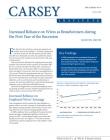
December 4, 2009
Among low-income families, the wages of employed wives account for the majority of family earnings, according to this Carsey brief. The analysis finds that in 2008, women contributed 56 percent of total family earnings, up from 51 percent in 2007. Also, husbands' education level and race are factors in how much wives contribute to family earnings.
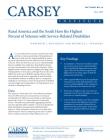
November 10, 2009
Veterans with service-related disabilities are concentrated in the American South and in rural places, this new fact sheet finds. Issued to commemorate Veterans Day (November 11), the report analyzes new data from the U.S. Census Bureau's 2008 American Community Survey, which released service-related disability data for the first time.
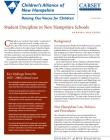
October 27, 2009
A new analysis of student discipline in New Hampshire schools in the 2007–2008 school year shows that out-of-school suspension rates are higher and statewide expulsion rates are lower than the national average. Schools reporting the highest rates of suspensions and expulsions are the smallest in the state and have the highest percentage of students in poverty. This brief is the first in a…
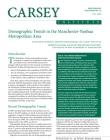
October 26, 2009
In the city of Manchester, New Hampshire, 25 percent of children live below the poverty line, a high rate that is in stark contrast to the state's rate of just 10 percent, one of the nation's lowest. That is the most surprising finding from this new analysis of demographic trends in the Manchester-Nashua metropolitan area. The brief presents recent demographic shifts in Manchester,…
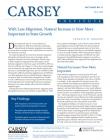
October 23, 2009
According to Johnson's analysis of U.S. Census Bureau data, the nation continues to experience reduced levels of domestic migration (movement from one state to another) as a result of the economic recession, and natural increases (births versus deaths) are an increasingly important factor in population gains.
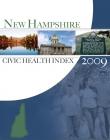
October 1, 2009
The Carsey Institute is participating in a national study to examine America's civic health. Led by the National Conference on Citizenship (NCoC), America's Civic Health Index is an annual study that measures a wide variety of civic indicators, such as community involvement and helping others. New Hampshire is one of six states partnering with NCoC to produce a state-specific report…
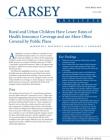
October 1, 2009
This Carsey brief looks at the geographic distribution of health insurance for children. Based on data from the 2008 American Community Survey, it includes such findings as one in ten children are still uninsured, insurance rates vary considerably by geographic area, and rural children are most likely to depend on public plans for their health care.
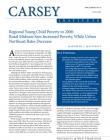
September 29, 2009
In 2008, America's recession affected poverty rates for children under age 6 unevenly, with rates in the rural Midwest rising significantly, while rates in northeastern central cities fell slightly. And in the rural South, where more than 30 percent of young children are poor, poverty rates for young children persisted at a very high rate. This is an analysis of American Community Survey…
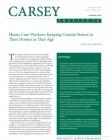
September 15, 2009
Using data from the New Hampshire Direct Care Workforce Survey, this brief shows that New Hampshire's demand for home-based care workers outpaces supply because its population is aging at a faster rate than the national average. These workers play a critical role and face many challenges, including low pay, little or no paid time off, and lack of access to health insurance.
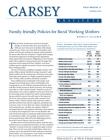
September 8, 2009
For working parents, family friendly work policies like paid sick days, flexible time, or medical insurance can reduce work-family conflict and lead to less absenteeism and higher productivity. Working parents in rural America, however, have less access to these policies than their urban counterparts.
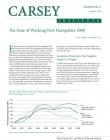
September 2, 2009
The issue brief finds that while New Hampshire workers have fared well compared with other New England states, wages have stagnated and full-time workers now form a smaller share of the labor force.
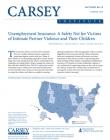
August 5, 2009
The Centers for Disease Control (CDC) estimates that over 5 million intimate partner assaults are perpetrated against women each year, and they lose more than 8 million days of work annually. Expanding Unemployment Insurance (UI) benefits to victims of domestic violence is one mechanism for supporting women as they seek to escape the violence in their lives.

June 29, 2009
One in five poor children in this country lives in a rural area. Yet this group of vulnerable young Americans is seldom on the minds of the public or policy makers when they talk about child poverty in the United States. This report highlights child poverty statistics in rural America and compares them to urban areas, discussing how they are affected by family, education, employment, and the…

June 29, 2009
As cohabiting increases nationwide, new data show that the growing rate of children in these households is most pronounced in rural areas. This brief analyzes recent U.S. Census Bureau data to explore these trends and patterns.

June 24, 2009
Workers in rural areas have historically worked at different times of the day compared to their counterparts in urban areas, including during less traditional work periods, such as in the early morning, afternoon, and evening hours. This brief presents a snapshot of the rural workforce around the clock.

June 22, 2009
When it comes to deciding whether to stay in New Hampshire's rural Coös County or leave for other opportunities, young people are listening to their parents. Surveying 78 percent of all seventh and eleventh graders in public schools in Coös County, researchers found that young peoples' future intentions to migrate from Coös in search of economic or educational opportunities or to remain…

June 1, 2009
This report focuses on the education and work experiences of rural youth during the emerging adult years (age 20 to 24), as they make the transition from adolescence to adulthood. It documents how rural emerging adults combine work and school and experience idleness, closely examines their educational attainment, and compares their experiences with those in central city and suburban areas.

May 17, 2009
Rural workers stand to benefit from the modernization of unemployment insurance (UI) to cover part-time workers, which is an opportunity for states under the American Reinvestment and Recovery Plan (ARRA). Rural workers are more likely to work part-time, and many states that do not provide UI benefits to part-time workers have higher than average proportions of rural residents.

May 13, 2009
The Making Work Pay Tax Credit provides eligible U.S. workers with additional money in each paycheck throughout the year. The fact sheet shows that 78 percent of rural working families will receive the full amount of the credit, while an additional 10 percent of families will receive a partial credit due to low earnings or high earnings. These tax credits, along with the expansion to the Child…

May 11, 2009
This policy brief on the changes to the Earned Income Tax Credit in the ARRA also shows that families with three or more children and married couples will receive an increased refund under these new EITC rules for tax years 2009 and 2010. Many families in urban and suburban communities will also see increased benefits under these new provisions.